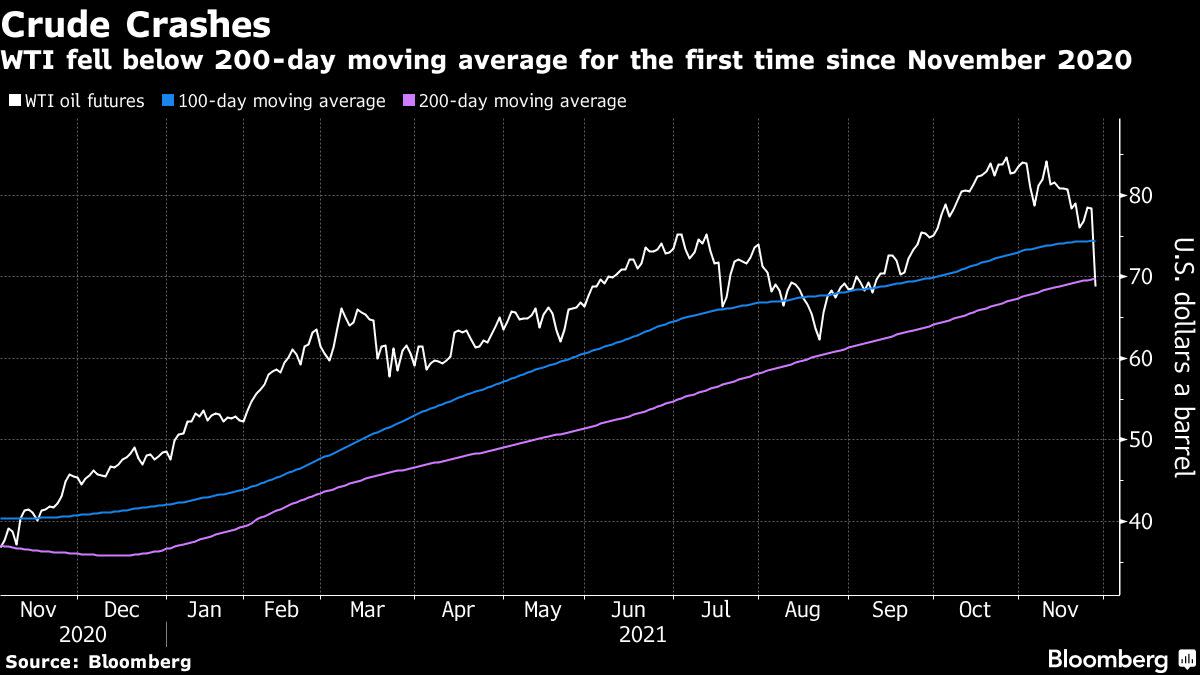
(Bloomberg) — Black Friday turned red very quickly for global oil markets.
The day after Thanksgiving has been choppy before — fewer traders can mean more volatility — but nothing like this year. The prospect of the freshly named Omicron variant of Covid derailing the world’s fight against the pandemic saw an early morning sell-off become a full-blown crash.
At the end, investors were rushing to cover short positions, analysts were ripping up forecasts and next week’s OPEC+ meeting was up in the air. West Texas Intermediate oil, the U.S. benchmark, closed 13% lower, the biggest decline since April 2020. Brent crude slumped 12%.
Oil had climbed fairly steadily through the year, staging a comeback as economic life gradually recovered from the pandemic, putting drivers back in cars and passengers into planes. Many analysts have global demand close to pre-pandemic levels above 100 million barrels a day. With OPEC+ keeping a tight grip on supply, several senior traders said $100 oil could be close.
But news of a fresh Covid-19 variant, which scientists fear could be more transmissible and less susceptible to vaccines than existing strains, sent familiar shivers through the market. Benchmark crude futures posted the biggest single-day plunge since the early days of the pandemic, showing just how fragile this recovery is.
“It’s been a crazy day in the markets that feels very reminiscent of last March,” said Craig Erlam, senior market analyst at Oanda Europe.
The initial plunge was driven by revived fears of widespread lockdowns and travel bans, but a host of technical factors, including anaemic post-holiday volumes, exacerbated the sell-off. The panic spread to every corner of the market from European diesel trades and time-spreads, the relative value of oil today to oil tomorrow, through to opaque options markets.
“Factors such as the break of technical support levels and an environment with lower liquidity post the Thanksgiving holiday have intensified the price drop,” said Giovanni Staunovo, commodity analyst at UBS Group AG.
It had already been an unusual week in the market. On Tuesday, the U.S. and other top oil consumers said they would release supplies from emergency reserves in a bid to curb surging energy costs. In response, the OPEC+ cartel, led by Saudi Arabia, had said it might scrap plans to increase production. London’s benchmark Brent prices rallied back above $80 a barrel.
But that was before Omicron.
Asia and and European trading saw a steady sell-off early on Friday, prices were down 5% by mid-morning in London. But the real excitement came in U.S. hours.
The market spiraled ever lower as oil broke through key technical levels — U.S. futures pierced their 100-day and 200-day moving averages. That gave algorithmic computer-driven trades the upper hand on a day when many participants were away from the market.
“The sell-off has no doubt been driven exacerbated by algo-driven trading as key technical levels broke down,” said Fawad Razaqzada, an analyst at ThinkMarkets.
Then the options market kicked in. When prices fall heavily, banks often sell futures contracts in order to hedge themselves against losses from put options — contracts that grant the right to sell at a particular price. Banks often sell puts to producers who want to protect against a bear market. This feedback loop, known as negative gamma to options traders, was seen as a factor on Friday.
“Dealers just took down hedges and they are shorter put options than normal, so must sell futures to hedge,” said Ilia Bouchouev, a partner at Pentathlon Investments and former head of oil derivatives at Koch Supply and Trading.
At the worst point of the crash, New York’s WTI futures slumped 14% from its pre-Thanksgiving close and London’s Brent collapsed more than 12%. By the close they’d both recovered slightly, but for London futures it was still the seventh worst one-day drop in history.
What happens next depends on whether the direst predictions for Omicron’s impact are realized.
Goldman Sachs Group Inc. said in a note that Friday’s move priced in a 4 million-barrel hit to demand over the next three months, nowhere close to the first lockdown, but more than enough to throw the market back into disarray. In any case, the Wall Street bank said that was excessive.
For many the crash is a buying opportunity because they expect prices to recover quickly when the U.S. market returns fully after the holiday and volumes return to normal. The longer-term outlook remains robust.
“This is a huge overreaction in terms of the market,” Amrita Sen, chief oil analyst at consultant Energy Aspects Ltd., said in a Bloomberg Television interview. “This is the market pricing in the worst possible scenarios.”
©2021 Bloomberg L.P.